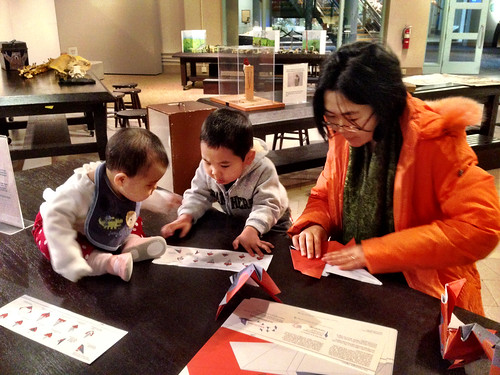 |
| We're reading instructions for mommy at the Carnegie Science Center. This is the next step. http://foldtheflock.org |
We have finally caved in to the suburban parenting pattern of enrichment classes. In our case we focused on the one thing that we do not provide: lessons in assertiveness. And the vehicle we chose was a local taekwondo studio that had started out around two years ago. We are not particularly interested in mastery, although if T wants this to be his sport for his growing up years, we would not be particularly disappointed. But we want him to relate to other adults (or at least older people) who are authority figures and can give instruction for him to follow and command respect.
Actually, we are more interested in that he can build confidence in action outside the safe harbor that we provide when we teach him things. When we first went, they were telling us about how martial arts classes in pre-schoolers helps in the case of pre-schoolers who need to burn off energy and bounce of the walls at home. As we have a child whose worst episodes of acting up are probably laughable to most parents of pre-schoolers, we replied that was not the problem. But what we are worried about is that he grow in confidence in action.
He is an introvert, and the son of two introverts, who are fully aware that much of the world is organized and evaluated with extroverts in mind. And we see that in his daycare. He was part of a trio of introverted boys. They have separated on their fourth birthdays to another daycare, the pre-K at our daycare, and the second pre-K class. And the one in the other pre-K class is worried of him being lost in the shuffle (it is large, the size is at the room physical limit. While on academic and artistic levels he is expressive (he is in a small class), when it comes to crowds (they merge in the afternoon) he still withdraws amidst the hurly burly of 20+ preschoolers running around.
The first sessions were what would be expected. As the class does their warmups, exercises, and yells, he withdraws. But, in a credit for this school (and the fact that there are few beginners at any point in time) he got some personal assistance from the school owner. So the first few session, he essentially had private classes, and now he takes his place with the rest of the (small) class. Progress!, and kudos for the school!
In other areas, he is enjoying his small, pre-K class. There are only around 8 students, and reports are that he is active talker in the group activities; circle time, singing, etc. Arts are slow, as he is very deliberate so projects take much longer than others, but he does them. He reverts to form when the classes merge in the afternoon (the extra space for the second pre-K class has another purpose in the afternoon).
He is increasing his academic abilities. With LEGO we went through the City Advent Calendar, which required that he take a small number of blocks and figure out how to make the object based on an iso-picture, as the month progressed, he was getting noticeably better at the spatial awareness, and doing the Christmas presents was much better at figuring out instructions by himself. He is also getting better at working with random pieces, as we build things and make up story lines to go with them.
He enjoys reading, especially as he is much more competent at phonics. He will pick out new books, and while he may ask us to read it, by 3-4 pages in he is doing most of the reading. We find it especially amusing when we he reads books to his little sister, because he does it using a teacher voice (as much as a four year old can imitate a teacher).
 |
| Making patterns with shapes on a light table |
A is becoming a sneaky little baby girl. She has started manipulative play, taking toys and waving them around. She can move things to her mouth, such as a toy, or more useful, her pacifier (funny event, sometimes when she wants to cry, she will use her hand to move the pacifier over so she can cry more effectively). Our other big observation was that she is now mobile. She can scoot. At the beginning of the month, we were not sure, because she does not move that fast. But give her a few minutes, she will have noticeably scooted on the playmat towards a desired goal. Our funny moment was when T was trying to play with A's toys (on the pretext of teaching A how to play with them), and she scooted over a couple feet and picked up one of his completed LEGO sets. We see a lot of that in the future.

